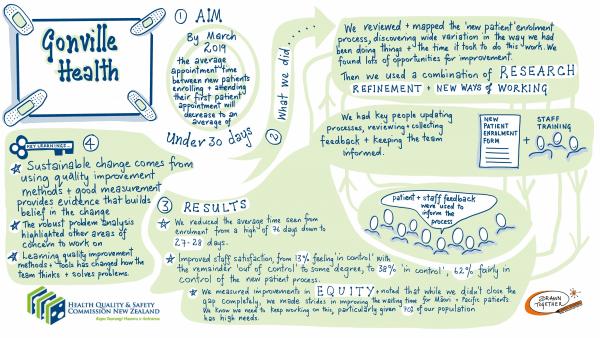Streamlining patient enrolment delivers extra benefits
A project to improve the patient enrolment process at Whanganui’s Gonville Health and make it more patient-centred and culturally appropriate has achieved benefits beyond its intended aims.
The project was undertaken as part of the 2018 Whakakotahi quality improvement programme, which aims to increase quality improvement capability in primary care.
Successful providers are supported by the Commission to implement quality improvement projects about an area of patient care that is important to their patients/community and to them as providers. Equity, consumer involvement and integration are key focus areas for Whakakotahi.
The Commission’s primary care programme team supports and mentors participating primary care teams through site visits and group learning events, and a member of each project team is offered a position on the primary care quality improvement facilitator course delivered by Ko Awatea and the Commission's primary care and leadership capability programmes.
Gonville Health is a Very Low Cost Access (VLCA) integrated family health practice with around 7000 enrolled patients, 70 percent of whom meet the high needs criteria. The practice has a higher than average population with complex health needs and the patients are more transient than those attending other non-VLCA clinics.
Service Manager, Janine Rider, says the practice was experiencing a high number of enrolments – 2637 new patients in less than 18 months – many with complex health needs, limited engagement in their health and needing support to achieve health literacy and self-management.
‘In many cases, the new patients arrived at the practice without good clinical notes. The administrative and clinical processes associated with enrolment were overwhelming our staff and jeopardising the creation of a good therapeutic relationship with each new patient.
‘For example, if a new patient had had cancer, it was often so far down in the notes that we had to go hunting for it to get them on the right surveillance. This created clinical risk for the patient and the practice team.
‘We needed an enrolment process that achieved the critical mix of what was clinically required to achieve best practice while making sure patients felt listened to, well cared for and supported to improve their health literacy and self-management.’
A review of the enrolment process identified changes that would reduce the time taken to enrol new patients as well as provide them with better support.
Quality improvements included simplifying the enrolment form, staff training to align the vision and approach and an evolving flow chart to support consistency.
‘Efficiencies were identified, the pressure was reduced and the team became more proactive about improvements and ideas,’ says Janine.
To help patients become engaged with both the practice and their health care journey as soon as possible, a key aim of the project was to reduce the average time between enrolment and the first appointment from around 63 days to under 30 days by March 2019. This was achieved five months early for all population groups and Janine says there have been many other ‘wins’.
‘We identified where risks lay as we went through the quality improvement process. For example, we created a cancer registry within the practice in response to cancer surveillance not being clearly documented in patient notes.’
Equity was a key focus of the project as Māori and Pacific Peoples had the longest delays between enrolment and their first appointment. Engagement was prioritised for these specific populations, and data was shared with staff to raise awareness on the inequities.
‘Equity is a continuing focus of our work as the gap between population enrolment delays has been significantly narrowed but not yet closed.’
She says doing the project under the Whakakotahi programme was key to its success.
‘Priorities go up and down, particularly within a VLCA practice. Being part of Whakakotahi made us accountable. It meant that even though other things came and went, and at times we lost focus, we knew we had to keep picking up this project because we were going to have to report on it in a fixed period of time.
‘As well as the tools gained through the primary care quality improvement facilitator’s course, I had access to Commission Quality Improvement Advisor, Jane Cullen, who helped us cement a quality improvement process.
‘We learnt that sustainable change will only come from using quality improvement methods and that good measurements provide evidence and encouragement.’
She says staff now know that all the information coming through from other practices is being reviewed intensively and, if clinically indicated, a nurse will support the patient by creating a care plan before their first routine GP appointment.
‘The result is that staff feel more in control and clinically safe, and we know more about our patients in a way that helps us partner with them towards being more engaged with Gonville Health and their personal health journey.
‘Anecdotally, there’s a level of calm that wasn’t there before because we were so busy trying to manage the load. There’s now a greater level of professionalism around the enrolment process and new patients feel like they’re being well looked after and are happier.’
Janine says Gonville Health is now planning to apply the quality improvement tools they’ve gained to all new projects.

An infographic outlining the project to streamline patient enrolment. Download a copy of the graphic (1MB, JPG)
